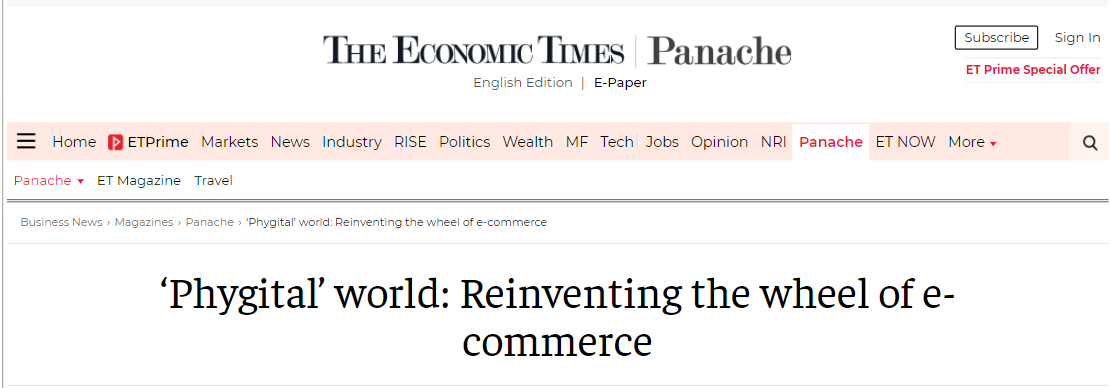As the second-fastest digitising nation in the world, India is on the path to becoming a $1-trillion digital economy by 2025. Maximising both online and of f line to fuel each other has become one of the top priorities of retailers today.
A recent Harvard Business Review article noted that “while e-commerce will continue to be an essential element of retail strategy, the future success of retailers will ultimately depend on creating a cohesive customer experience, both online and and in stores”.
While e-commerce sales will continue to grow, Google’s research shows that the pandemic has made people more flexible about online retailer businesses. So, how can retailers be prepared for this new ‘phygital’ world that we are living in today?
A recent Harvard Business Review article noted that “while e-commerce will continue to be an essential element of retail strategy, the future success of retailers will ultimately depend on creating a cohesive customer experience, both online and and in stores”.
While e-commerce sales will continue to grow, Google’s research shows that the pandemic has made people more flexible about online retailer businesses. So, how can retailers be prepared for this new ‘phygital’ world that we are living in today?
Every retailer, from grocery to luxury fashion, needs to fully understand that his customers’ shopping habits have permanently changed. The wide adoption of e-commerce means that the consumer’s expectations across service, convenience and ease of navigation will need to be translated into the physical retail experience in order to entice people to shop in-store. Investing in the tools that will al low retailers to manage or even exceed their customers’ expectations will be the key to a successful merging of the physical and digital environments.
Digital natives
The Indian retail market is the world’s third-largest consumer market, where 65 per cent of discovery happens online and 97 per cent of shopping takes place offline.
The winner will be the one who can offer an affordable, high quality experience both online and offline to a billion people. A recent article stated that there are 70 million online shoppers in India, of which only 10 million can be classified as ‘digital natives’. These numbers mean that today in a country of 1.3 billion people, less than one per cent would be considered digital natives.
The Indian retail market is the world’s third-largest consumer market, where 65 per cent of discovery happens online and 97 per cent of shopping takes place offline.
The winner will be the one who can offer an affordable, high quality experience both online and offline to a billion people. A recent article stated that there are 70 million online shoppers in India, of which only 10 million can be classified as ‘digital natives’. These numbers mean that today in a country of 1.3 billion people, less than one per cent would be considered digital natives.
Getting phygital
The significant investments and businesses that have been seen in unorganised retail over the past few years suggest that investors and entrepreneurs realise that Indian unorganised retail presents a massive opportunity. The solution for growth and opportunity is the use of technology to make unorganised retail more efficient. Area Online is the concept of phygital of the current era, which envisages hyper-local distribution as shared by Yatin Shah, founder, Area Online would be considered digital natives.
The significant investments and businesses that have been seen in unorganised retail over the past few years suggest that investors and entrepreneurs realise that Indian unorganised retail presents a massive opportunity. The solution for growth and opportunity is the use of technology to make unorganised retail more efficient. Area Online is the concept of phygital of the current era, which envisages hyper-local distribution as shared by Yatin Shah, founder, Area Online would be considered digital natives.
Area Online generates value for both the stores and the consumers.
To understand this better, let us look at what the unorganised retail sector lacks, and the solution lies in the phygital concept of Area Online:
To understand this better, let us look at what the unorganised retail sector lacks, and the solution lies in the phygital concept of Area Online:
-
Real-time data of retailer/shopkeeper and their product and service.
-
The webpage of each customer, making it local to global.
-
Enriching each local shopping area with area online.
-
A supply chain that is modernised to deal with a demanding consumer.
-
Technology that links the consumer to the factory/shops/households/retailers.
-
The ability to generate demand. 7 Acquire consumers over and above the usual walk-ins.
“Phygital commerce has the ability to use the unorganised retail assets to integrate everyone — all the way from the consumer to the factory — and create massive scale to serve a billion people. This is where the real value creation and opportunity lie,” says Shah.
Area Online offers you your own online store in less than 60 seconds, where you can display all your products and services online. It gives end-to-end solutions, no commission charged, and environments where shops/retailers can sell their products/services directly to customers without any aggregators.
Area Online offers you your own online store in less than 60 seconds, where you can display all your products and services online. It gives end-to-end solutions, no commission charged, and environments where shops/retailers can sell their products/services directly to customers without any aggregators.


